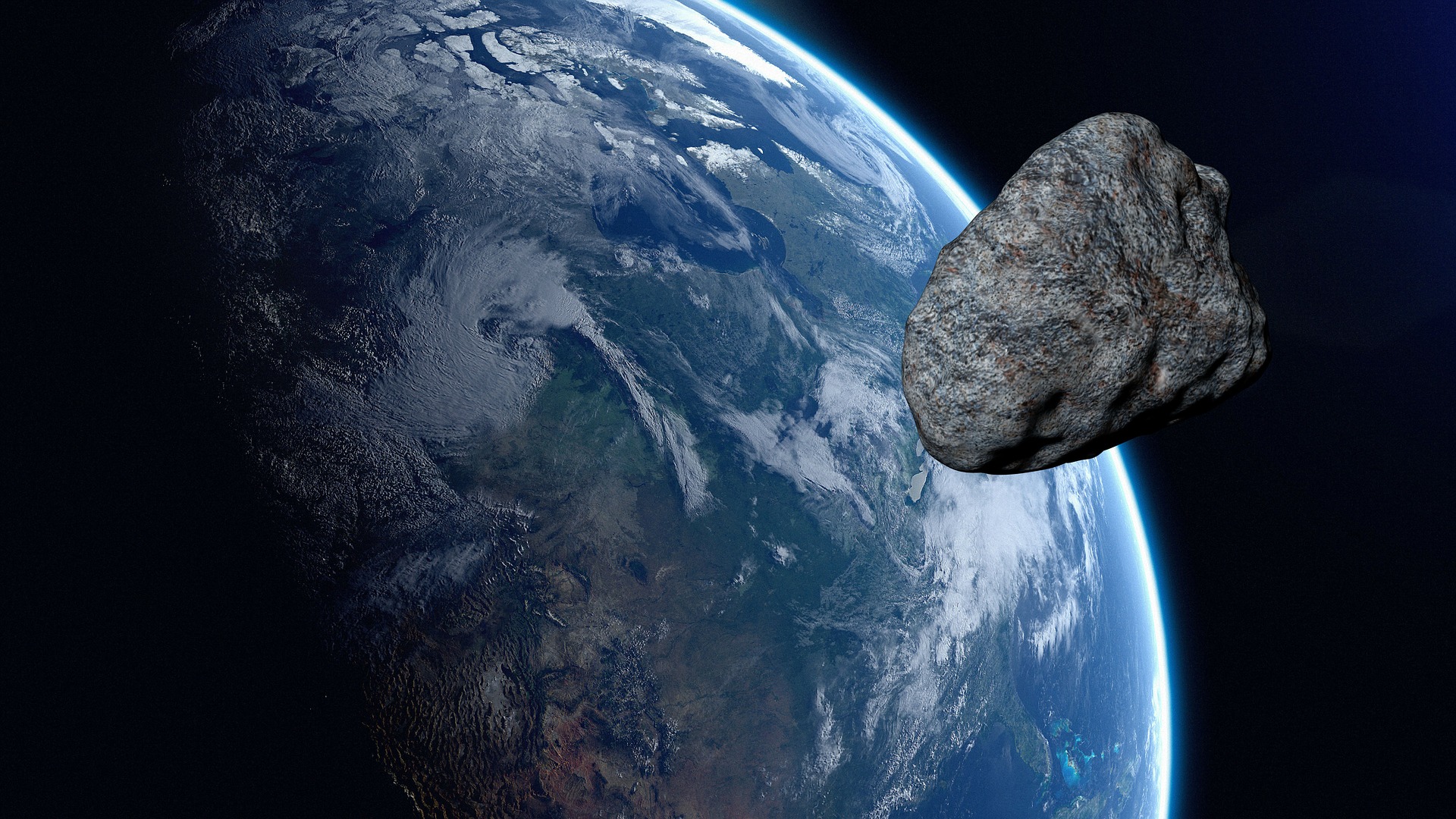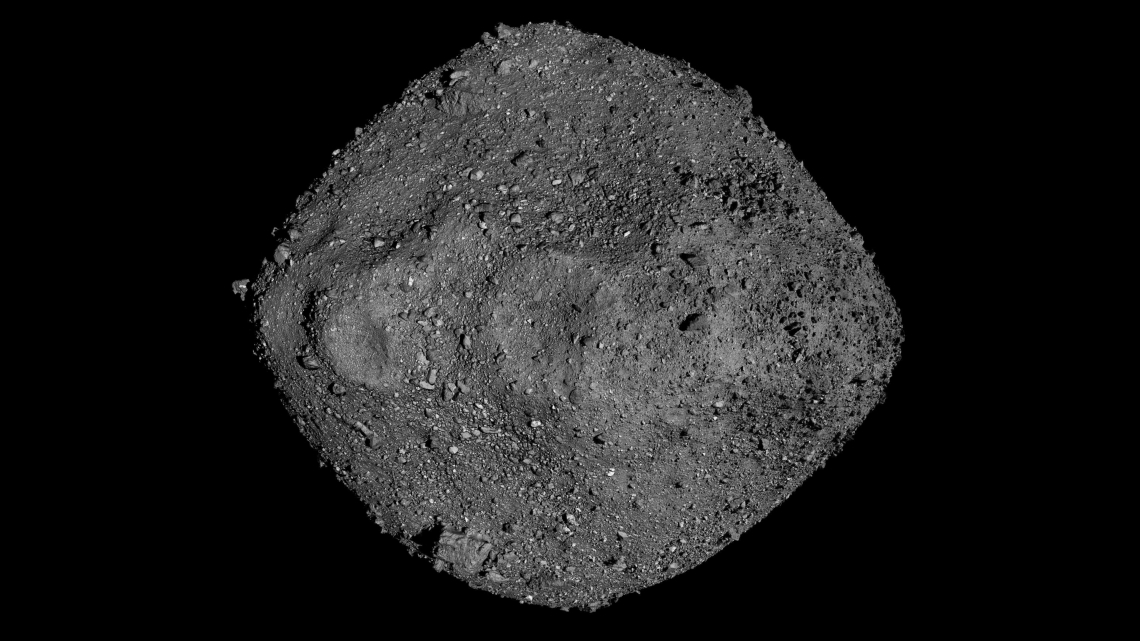 Artist conception of asteroid approaching Earth.
Artist conception of asteroid approaching Earth.
What are near-Earth objects?
Near-Earth Objects (NEOs) include both asteroids and comets whose orbit brings them relatively close to Earth’s orbit around the Sun. Specifically, they come within 225 million kilometers of the Sun, which is about 1.3 times the Earth’s average distance from the Sun. Asteroids are small (compared with planets), usually rocky bodies that orbit the Sun. They range from several meters to several kilometers in size. Comets also orbit the Sun, and can be thought of as dirty ice balls. They become “active” when they approach the Sun and its energy warms the ice, releasing both water vapor and dust, forming a distinctive “tail” of particles. Comets tend to have much more elliptically shaped orbits than asteroids and planets, and their cores can be many kilometers across.
Why is it important to search for near-Earth objects?
More than 3 million asteroids approach the orbit of Earth, ranging in size from 20 meters to more than 1 kilometer in size. Comets and asteroids that come within 7.5 million kilometers of Earth’s orbit are considered “potentially hazardous objects.” Objects larger than 40 meters that impact Earth are likely to cause significant damage and the vast majority of these objects are still un-located. While NASA’s DART mission showed the feasibility of deflecting an asteroid to defend Earth, we have to find them before they find us. Throughout Earth’s history, asteroids of various sizes have impacted Earth, causing considerable destruction, including the extinction event that killed off the dinosaurs.
Recognizing the hazard near-Earth asteroids represent, in 2005, Congress assigned NASA the mission to “detect, track, catalogue, and characterize” 90% of near-Earth objects of 140 meters diameter or larger. The deadline for meeting the goal was December 2020, yet as of now we have only reached about 42%.
The National Academy of Science has released several reports in 2010, 2019, and most recently the Planetary Science and Astrobiology Decadal Survey (2022), all supporting a space-based telescope operating in the IR spectrum, as the best way to detect and characterize NEOs.
Why is NEO Surveyor so important in the search for near-Earth objects?
NEO Surveyor provides the fastest way to accelerate the detection of 140 meter and larger asteroids. About 25,000 asteroids in this size exist, with less than 40% of them located. NEO Surveyor is expected to help achieve the 90% Congressional goal in as little as ten years of operation, about 20 years earlier than current methods alone could hope to reach the goal. Earlier completion will give humanity more time to prepare should a major impactor be located. NEO Surveyor will also have an excellent ability to locate asteroids sized 40-140 meters, which could still cause major destruction. There are thought to be about half a million near-Earth objects of this size, of which less than 2% are located.
Will NEO Surveyor replace ground-based detection and observation of asteroids?
No. While NEO Surveyor will be able to detect and characterize asteroids better than telescopes on the ground, it cannot look everywhere at once. Observations by amateur astronomers and surveys by professional astronomers will still be important. Subsequent observations of asteroids help refine their orbits, which is necessary to make impact hazard predictions. It takes at least three observations of an asteroid to determine its orbit, and more still to refine Its accuracy.
How will NEO Surveyor observations differ from current ground-based methods?
From its orbit at Sun-Earth Lagrange Point 1, a gravitationally stable point between Earth and the Sun, NEO Surveyor will be able to see asteroids that are closer to the Sun than is generally possible from Earth. Ground-based optical telescopes cannot operate during daylight hours, and the Sun’s glare makes detecting asteroids in the general direction of the Sun extremely difficult.
Unobstructed by haze, clouds and water vapor in the atmosphere, NEO Surveyor’s infra-red (IR) camera will detect asteroids that are too dark to see from Earth-based telescopes. And NEO Surveyor’s IR observations will help assess the size of asteroids more accurately than optical telescopes on Earth.
Additionally, NASA has found that terrestrial detection of NEOs is already being made more difficult by reflected light from the increasing number of “megaconstellation” satellites in low Earth obit.
How much will NEO Surveyor cost?
As originally planned, NEO Surveyor would cost about $600 million. That’s comparable to the budgets of four big-budget Hollywood blockbusters, the annual budget for about seven small cities. But thanks to delays in approval, COVID-19 disruptions, and NASA-enacted budget cuts in 2022, it will cost more, perhaps closer to $1 billion to launch NEO Surveyor.
Will NEO Surveyor make a difference in the search for near-Earth objects?
Absolutely. As of December 2021, NASA estimated it would take until 2051 at the earliest to meet the Congressional mandate to locate 90% of the near-Earth objects that would cause regional devastation if they struck Earth. There are thousands of these asteroids. With NEO Surveyor in operation, it’s expected to take only about 10 years to reach the goal. NEO Surveyor will also have an excellent ability to locate many of the 500,000 asteroids sized 40-140 meters, which threaten significant destruction.
 Photo of near-Earth asteroid Bennu courtesy NASA.
Photo of near-Earth asteroid Bennu courtesy NASA.







